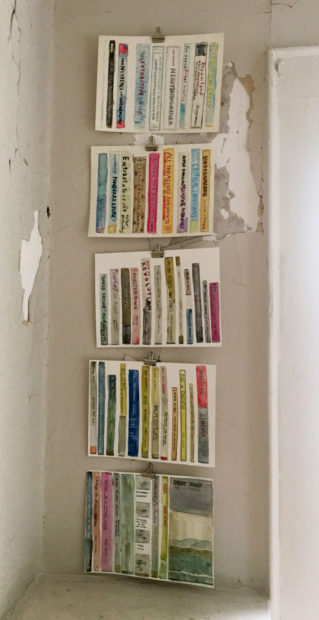Borderland Rivers Watercolor Bibliography
One of the magical synchronicities of the Works on Water / Underwater New York residency was that my studio was across the hall from Nicole Antebi’s. We were both on the top floor with our doors facing one another. It wasn’t long before we discovered that both our research and projects were focused on a river that articulates an international border of the United States—hers, the Rio Grande bordering Mexico, and mine the St. Lawrence River, bordering Canada. We are both interested in complexities, social and ecological justice issues, ideas around belonging… We shared our bibliographies and Nicole initiated a collaboration in which we each made watercolor images of our books. We hung our north and south oriented watercolor book spines in the library in the public area of the residency house on the first floor.
Nicole makes wonderful animations and recently published a great interview with historian David Dorado Romo about the fight to preserve the oldest barrio in El Paso. It is featured here on Longreads: The City I Love Is Destroying Itself.
Color Studies / Body Radio
A couple weeks ago I visited Parson’s Hall Project Space in Holyoke, MA, a gallery in an old industrial building owned, renovated and occupied by Torsten Burns and Kari Gatske. The renovations are beautiful and there was a great turnout for the opening in the project space. I finally had an excuse to make a piece I’ve been mulling over for months: Color Studies (After Albers) for the show, Body Radio, which shares the space with the launch of the Strange Attractors compilation.
A few years ago a friend found a 40+ snapshots “in a dumpster” of a bunch of business men in a hotel suite, with a stripper in the 80s or early 90s. Following the logic of Josef Albers’ Homage to the Square color studies I made formal paintings from the shapes in these images using gouache. I was attempting to organize a dual way of perceiving these images – the perceptual and formal color relationships (“chromatic interactions”) should merge with the curious social dynamics and power relations of the scene.

